Nursing Case Study: Trevor and Katrina's Health Conditions
VerifiedAdded on 2021/06/14
|13
|3365
|21
Case Study
AI Summary
This case study analyzes the health conditions of Trevor, a 61-year-old with ischemic heart disease, type 2 diabetes, and hypertension, and Katrina, whose family history puts her at risk of hypertension. The study explores the etiology, signs, symptoms, and risk factors of Ischemic Heart Disease (IHD), including the role of lifestyle factors like smoking, diet, and exercise. It discusses diagnostic tests such as electrocardiography and Holter monitoring, and the potential progression to hypertension and stroke. The study also examines the prevalence, causes, and grading system for hypertension in Australia, comparing it to the USA, and differentiating between modifiable and non-modifiable risk factors. The case highlights the importance of lifestyle changes, such as diet and exercise, and the role of family history in health outcomes, providing an overview of disease management and nursing implications.
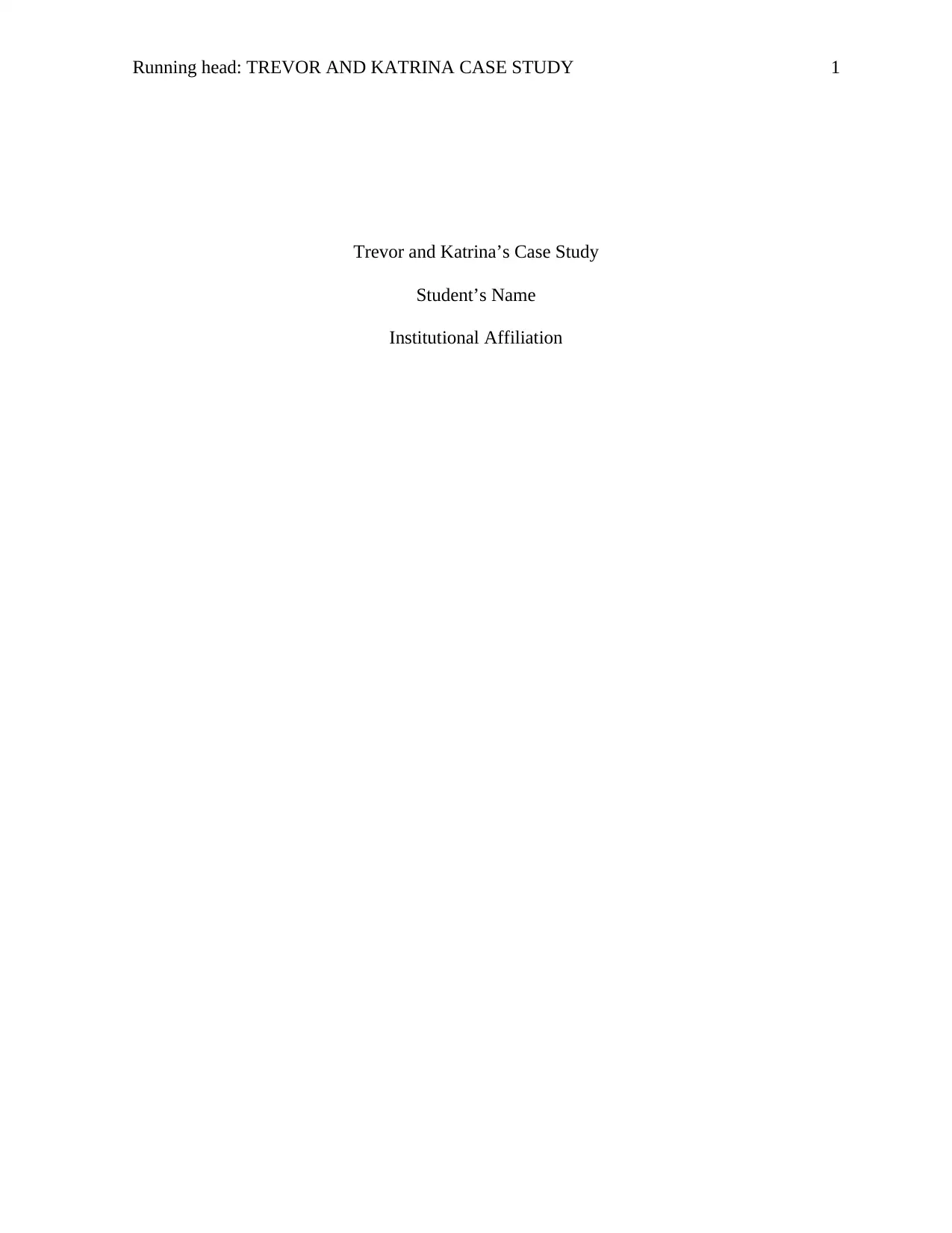
Running head: TREVOR AND KATRINA CASE STUDY 1
Trevor and Katrina’s Case Study
Student’s Name
Institutional Affiliation
Trevor and Katrina’s Case Study
Student’s Name
Institutional Affiliation
Paraphrase This Document
Need a fresh take? Get an instant paraphrase of this document with our AI Paraphraser
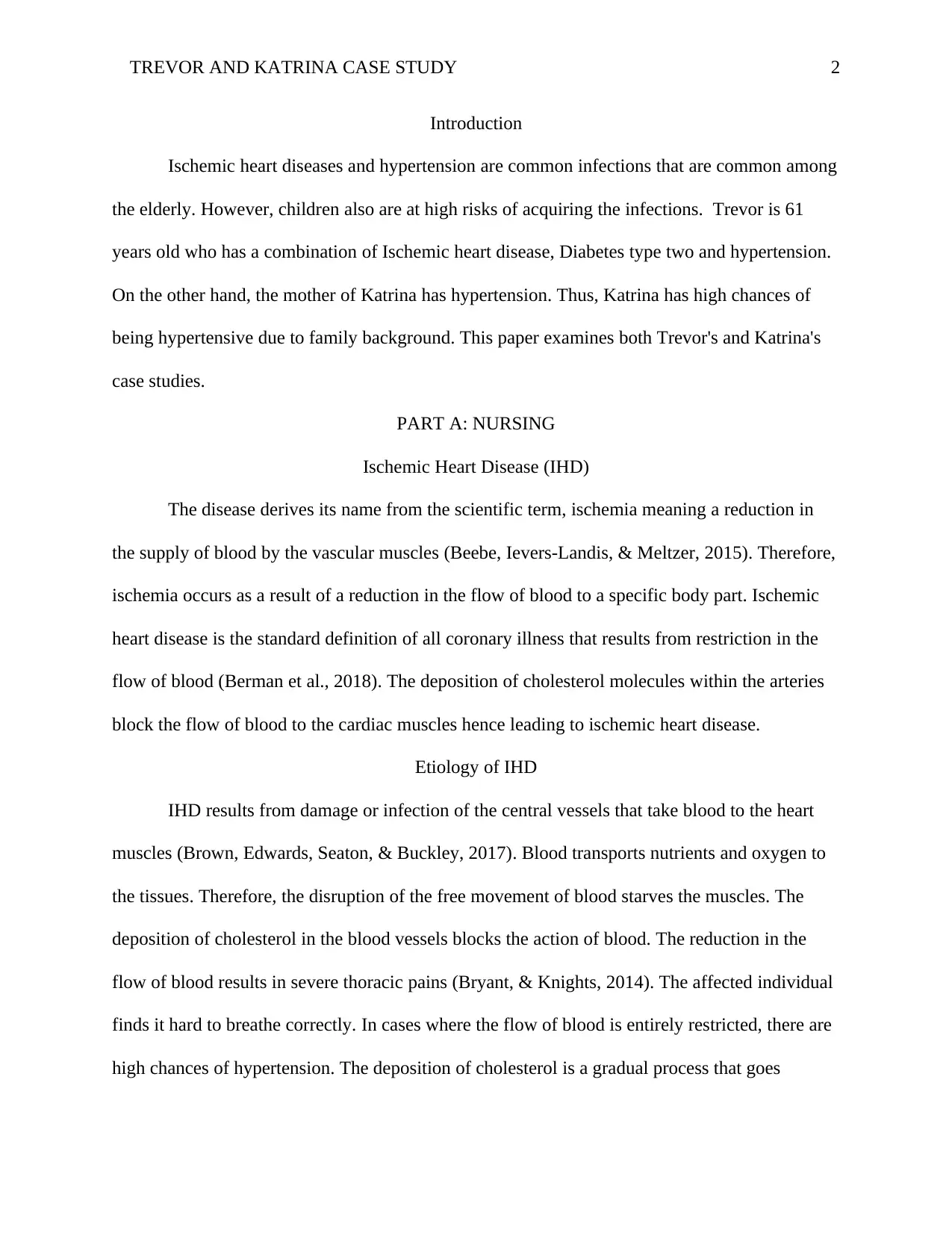
TREVOR AND KATRINA CASE STUDY 2
Introduction
Ischemic heart diseases and hypertension are common infections that are common among
the elderly. However, children also are at high risks of acquiring the infections. Trevor is 61
years old who has a combination of Ischemic heart disease, Diabetes type two and hypertension.
On the other hand, the mother of Katrina has hypertension. Thus, Katrina has high chances of
being hypertensive due to family background. This paper examines both Trevor's and Katrina's
case studies.
PART A: NURSING
Ischemic Heart Disease (IHD)
The disease derives its name from the scientific term, ischemia meaning a reduction in
the supply of blood by the vascular muscles (Beebe, Ievers-Landis, & Meltzer, 2015). Therefore,
ischemia occurs as a result of a reduction in the flow of blood to a specific body part. Ischemic
heart disease is the standard definition of all coronary illness that results from restriction in the
flow of blood (Berman et al., 2018). The deposition of cholesterol molecules within the arteries
block the flow of blood to the cardiac muscles hence leading to ischemic heart disease.
Etiology of IHD
IHD results from damage or infection of the central vessels that take blood to the heart
muscles (Brown, Edwards, Seaton, & Buckley, 2017). Blood transports nutrients and oxygen to
the tissues. Therefore, the disruption of the free movement of blood starves the muscles. The
deposition of cholesterol in the blood vessels blocks the action of blood. The reduction in the
flow of blood results in severe thoracic pains (Bryant, & Knights, 2014). The affected individual
finds it hard to breathe correctly. In cases where the flow of blood is entirely restricted, there are
high chances of hypertension. The deposition of cholesterol is a gradual process that goes
Introduction
Ischemic heart diseases and hypertension are common infections that are common among
the elderly. However, children also are at high risks of acquiring the infections. Trevor is 61
years old who has a combination of Ischemic heart disease, Diabetes type two and hypertension.
On the other hand, the mother of Katrina has hypertension. Thus, Katrina has high chances of
being hypertensive due to family background. This paper examines both Trevor's and Katrina's
case studies.
PART A: NURSING
Ischemic Heart Disease (IHD)
The disease derives its name from the scientific term, ischemia meaning a reduction in
the supply of blood by the vascular muscles (Beebe, Ievers-Landis, & Meltzer, 2015). Therefore,
ischemia occurs as a result of a reduction in the flow of blood to a specific body part. Ischemic
heart disease is the standard definition of all coronary illness that results from restriction in the
flow of blood (Berman et al., 2018). The deposition of cholesterol molecules within the arteries
block the flow of blood to the cardiac muscles hence leading to ischemic heart disease.
Etiology of IHD
IHD results from damage or infection of the central vessels that take blood to the heart
muscles (Brown, Edwards, Seaton, & Buckley, 2017). Blood transports nutrients and oxygen to
the tissues. Therefore, the disruption of the free movement of blood starves the muscles. The
deposition of cholesterol in the blood vessels blocks the action of blood. The reduction in the
flow of blood results in severe thoracic pains (Bryant, & Knights, 2014). The affected individual
finds it hard to breathe correctly. In cases where the flow of blood is entirely restricted, there are
high chances of hypertension. The deposition of cholesterol is a gradual process that goes
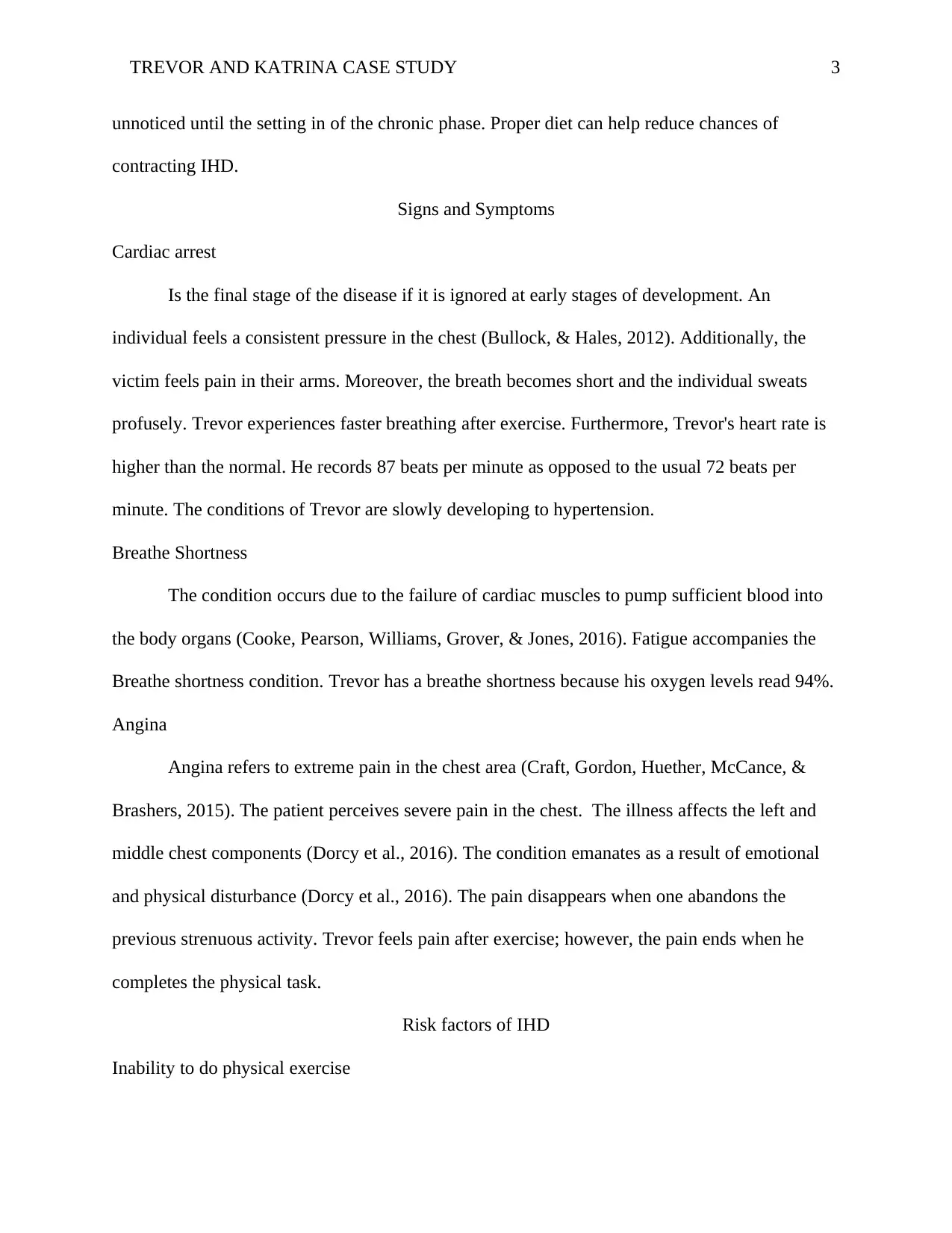
TREVOR AND KATRINA CASE STUDY 3
unnoticed until the setting in of the chronic phase. Proper diet can help reduce chances of
contracting IHD.
Signs and Symptoms
Cardiac arrest
Is the final stage of the disease if it is ignored at early stages of development. An
individual feels a consistent pressure in the chest (Bullock, & Hales, 2012). Additionally, the
victim feels pain in their arms. Moreover, the breath becomes short and the individual sweats
profusely. Trevor experiences faster breathing after exercise. Furthermore, Trevor's heart rate is
higher than the normal. He records 87 beats per minute as opposed to the usual 72 beats per
minute. The conditions of Trevor are slowly developing to hypertension.
Breathe Shortness
The condition occurs due to the failure of cardiac muscles to pump sufficient blood into
the body organs (Cooke, Pearson, Williams, Grover, & Jones, 2016). Fatigue accompanies the
Breathe shortness condition. Trevor has a breathe shortness because his oxygen levels read 94%.
Angina
Angina refers to extreme pain in the chest area (Craft, Gordon, Huether, McCance, &
Brashers, 2015). The patient perceives severe pain in the chest. The illness affects the left and
middle chest components (Dorcy et al., 2016). The condition emanates as a result of emotional
and physical disturbance (Dorcy et al., 2016). The pain disappears when one abandons the
previous strenuous activity. Trevor feels pain after exercise; however, the pain ends when he
completes the physical task.
Risk factors of IHD
Inability to do physical exercise
unnoticed until the setting in of the chronic phase. Proper diet can help reduce chances of
contracting IHD.
Signs and Symptoms
Cardiac arrest
Is the final stage of the disease if it is ignored at early stages of development. An
individual feels a consistent pressure in the chest (Bullock, & Hales, 2012). Additionally, the
victim feels pain in their arms. Moreover, the breath becomes short and the individual sweats
profusely. Trevor experiences faster breathing after exercise. Furthermore, Trevor's heart rate is
higher than the normal. He records 87 beats per minute as opposed to the usual 72 beats per
minute. The conditions of Trevor are slowly developing to hypertension.
Breathe Shortness
The condition occurs due to the failure of cardiac muscles to pump sufficient blood into
the body organs (Cooke, Pearson, Williams, Grover, & Jones, 2016). Fatigue accompanies the
Breathe shortness condition. Trevor has a breathe shortness because his oxygen levels read 94%.
Angina
Angina refers to extreme pain in the chest area (Craft, Gordon, Huether, McCance, &
Brashers, 2015). The patient perceives severe pain in the chest. The illness affects the left and
middle chest components (Dorcy et al., 2016). The condition emanates as a result of emotional
and physical disturbance (Dorcy et al., 2016). The pain disappears when one abandons the
previous strenuous activity. Trevor feels pain after exercise; however, the pain ends when he
completes the physical task.
Risk factors of IHD
Inability to do physical exercise
⊘ This is a preview!⊘
Do you want full access?
Subscribe today to unlock all pages.

Trusted by 1+ million students worldwide
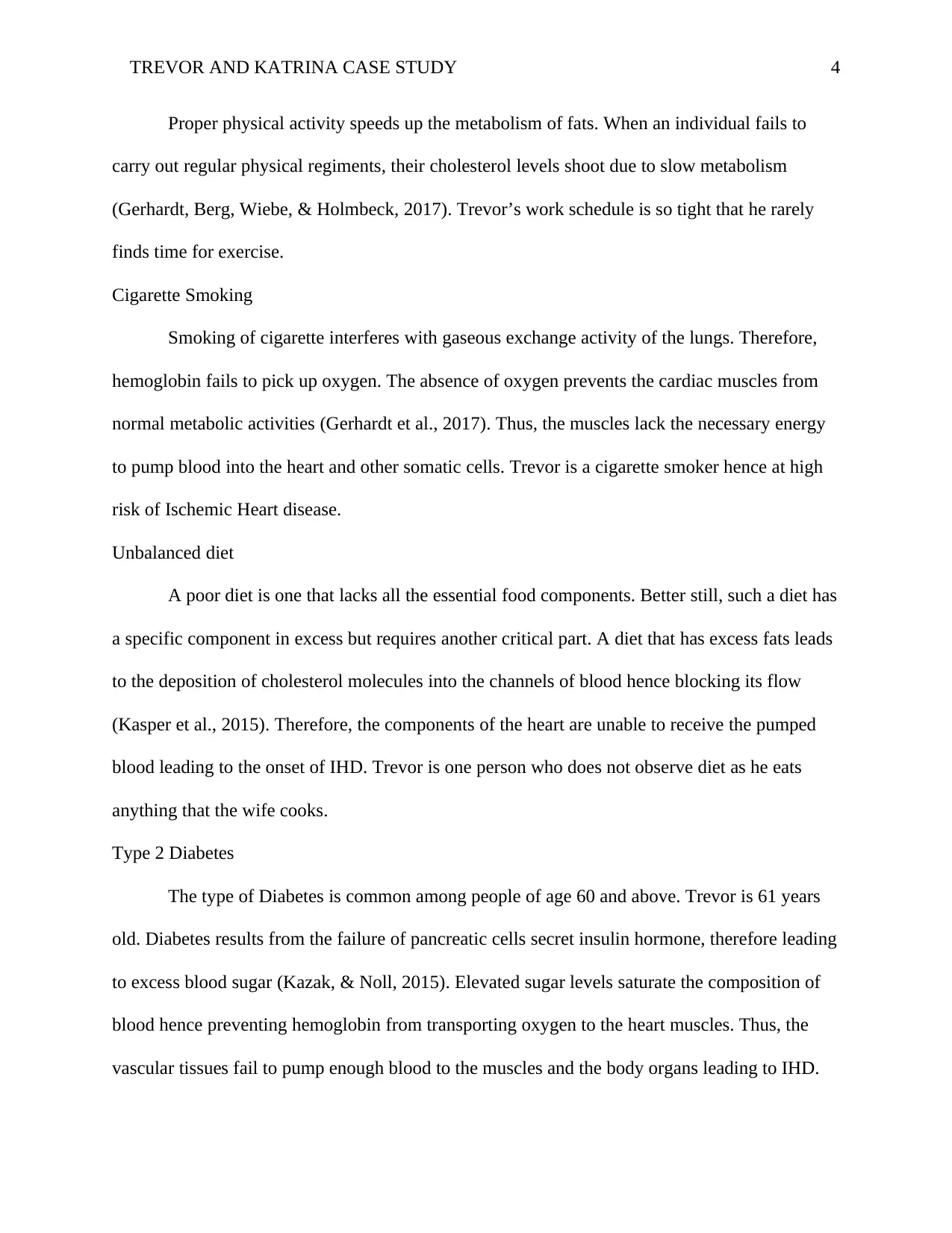
TREVOR AND KATRINA CASE STUDY 4
Proper physical activity speeds up the metabolism of fats. When an individual fails to
carry out regular physical regiments, their cholesterol levels shoot due to slow metabolism
(Gerhardt, Berg, Wiebe, & Holmbeck, 2017). Trevor’s work schedule is so tight that he rarely
finds time for exercise.
Cigarette Smoking
Smoking of cigarette interferes with gaseous exchange activity of the lungs. Therefore,
hemoglobin fails to pick up oxygen. The absence of oxygen prevents the cardiac muscles from
normal metabolic activities (Gerhardt et al., 2017). Thus, the muscles lack the necessary energy
to pump blood into the heart and other somatic cells. Trevor is a cigarette smoker hence at high
risk of Ischemic Heart disease.
Unbalanced diet
A poor diet is one that lacks all the essential food components. Better still, such a diet has
a specific component in excess but requires another critical part. A diet that has excess fats leads
to the deposition of cholesterol molecules into the channels of blood hence blocking its flow
(Kasper et al., 2015). Therefore, the components of the heart are unable to receive the pumped
blood leading to the onset of IHD. Trevor is one person who does not observe diet as he eats
anything that the wife cooks.
Type 2 Diabetes
The type of Diabetes is common among people of age 60 and above. Trevor is 61 years
old. Diabetes results from the failure of pancreatic cells secret insulin hormone, therefore leading
to excess blood sugar (Kazak, & Noll, 2015). Elevated sugar levels saturate the composition of
blood hence preventing hemoglobin from transporting oxygen to the heart muscles. Thus, the
vascular tissues fail to pump enough blood to the muscles and the body organs leading to IHD.
Proper physical activity speeds up the metabolism of fats. When an individual fails to
carry out regular physical regiments, their cholesterol levels shoot due to slow metabolism
(Gerhardt, Berg, Wiebe, & Holmbeck, 2017). Trevor’s work schedule is so tight that he rarely
finds time for exercise.
Cigarette Smoking
Smoking of cigarette interferes with gaseous exchange activity of the lungs. Therefore,
hemoglobin fails to pick up oxygen. The absence of oxygen prevents the cardiac muscles from
normal metabolic activities (Gerhardt et al., 2017). Thus, the muscles lack the necessary energy
to pump blood into the heart and other somatic cells. Trevor is a cigarette smoker hence at high
risk of Ischemic Heart disease.
Unbalanced diet
A poor diet is one that lacks all the essential food components. Better still, such a diet has
a specific component in excess but requires another critical part. A diet that has excess fats leads
to the deposition of cholesterol molecules into the channels of blood hence blocking its flow
(Kasper et al., 2015). Therefore, the components of the heart are unable to receive the pumped
blood leading to the onset of IHD. Trevor is one person who does not observe diet as he eats
anything that the wife cooks.
Type 2 Diabetes
The type of Diabetes is common among people of age 60 and above. Trevor is 61 years
old. Diabetes results from the failure of pancreatic cells secret insulin hormone, therefore leading
to excess blood sugar (Kazak, & Noll, 2015). Elevated sugar levels saturate the composition of
blood hence preventing hemoglobin from transporting oxygen to the heart muscles. Thus, the
vascular tissues fail to pump enough blood to the muscles and the body organs leading to IHD.
Paraphrase This Document
Need a fresh take? Get an instant paraphrase of this document with our AI Paraphraser
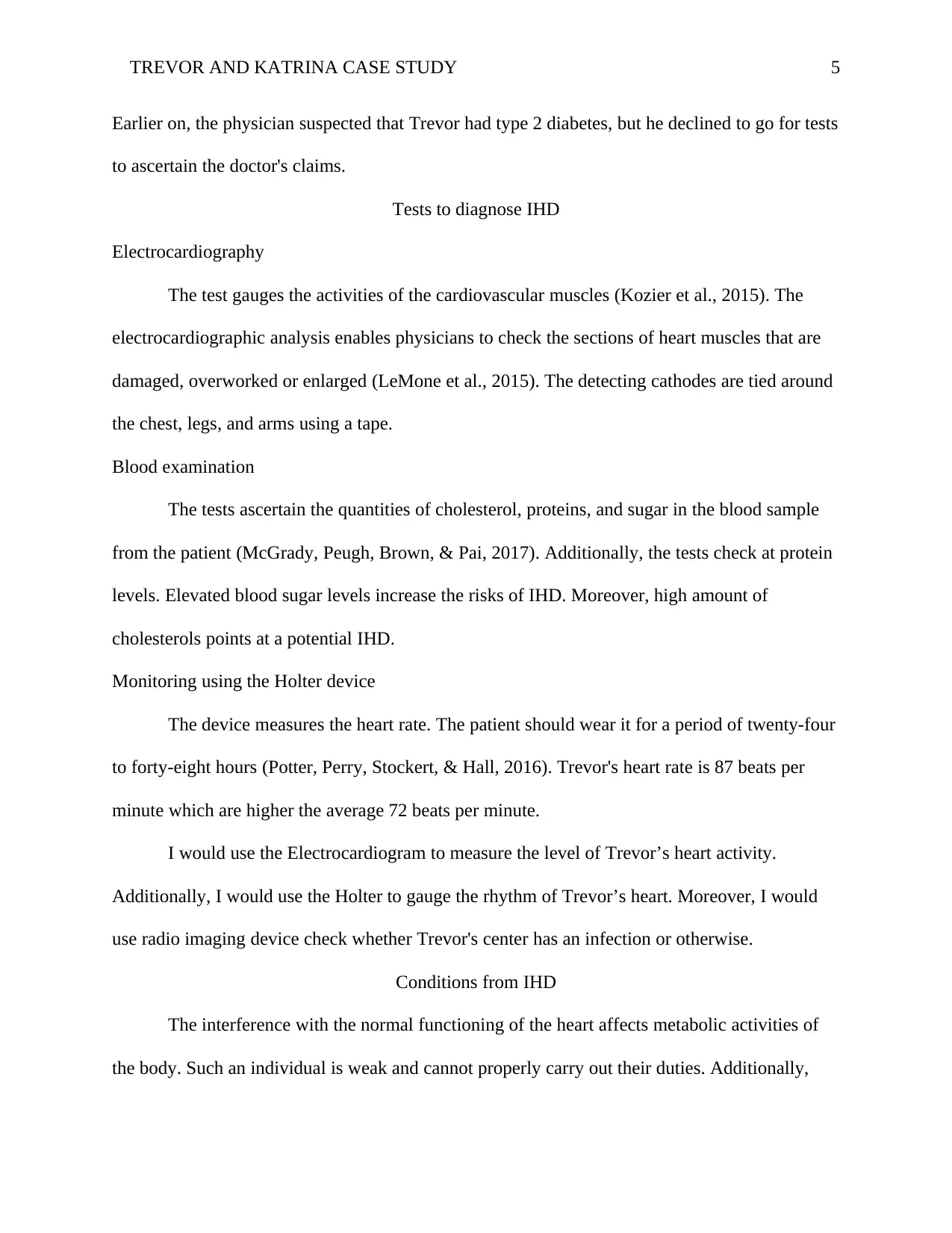
TREVOR AND KATRINA CASE STUDY 5
Earlier on, the physician suspected that Trevor had type 2 diabetes, but he declined to go for tests
to ascertain the doctor's claims.
Tests to diagnose IHD
Electrocardiography
The test gauges the activities of the cardiovascular muscles (Kozier et al., 2015). The
electrocardiographic analysis enables physicians to check the sections of heart muscles that are
damaged, overworked or enlarged (LeMone et al., 2015). The detecting cathodes are tied around
the chest, legs, and arms using a tape.
Blood examination
The tests ascertain the quantities of cholesterol, proteins, and sugar in the blood sample
from the patient (McGrady, Peugh, Brown, & Pai, 2017). Additionally, the tests check at protein
levels. Elevated blood sugar levels increase the risks of IHD. Moreover, high amount of
cholesterols points at a potential IHD.
Monitoring using the Holter device
The device measures the heart rate. The patient should wear it for a period of twenty-four
to forty-eight hours (Potter, Perry, Stockert, & Hall, 2016). Trevor's heart rate is 87 beats per
minute which are higher the average 72 beats per minute.
I would use the Electrocardiogram to measure the level of Trevor’s heart activity.
Additionally, I would use the Holter to gauge the rhythm of Trevor’s heart. Moreover, I would
use radio imaging device check whether Trevor's center has an infection or otherwise.
Conditions from IHD
The interference with the normal functioning of the heart affects metabolic activities of
the body. Such an individual is weak and cannot properly carry out their duties. Additionally,
Earlier on, the physician suspected that Trevor had type 2 diabetes, but he declined to go for tests
to ascertain the doctor's claims.
Tests to diagnose IHD
Electrocardiography
The test gauges the activities of the cardiovascular muscles (Kozier et al., 2015). The
electrocardiographic analysis enables physicians to check the sections of heart muscles that are
damaged, overworked or enlarged (LeMone et al., 2015). The detecting cathodes are tied around
the chest, legs, and arms using a tape.
Blood examination
The tests ascertain the quantities of cholesterol, proteins, and sugar in the blood sample
from the patient (McGrady, Peugh, Brown, & Pai, 2017). Additionally, the tests check at protein
levels. Elevated blood sugar levels increase the risks of IHD. Moreover, high amount of
cholesterols points at a potential IHD.
Monitoring using the Holter device
The device measures the heart rate. The patient should wear it for a period of twenty-four
to forty-eight hours (Potter, Perry, Stockert, & Hall, 2016). Trevor's heart rate is 87 beats per
minute which are higher the average 72 beats per minute.
I would use the Electrocardiogram to measure the level of Trevor’s heart activity.
Additionally, I would use the Holter to gauge the rhythm of Trevor’s heart. Moreover, I would
use radio imaging device check whether Trevor's center has an infection or otherwise.
Conditions from IHD
The interference with the normal functioning of the heart affects metabolic activities of
the body. Such an individual is weak and cannot properly carry out their duties. Additionally,
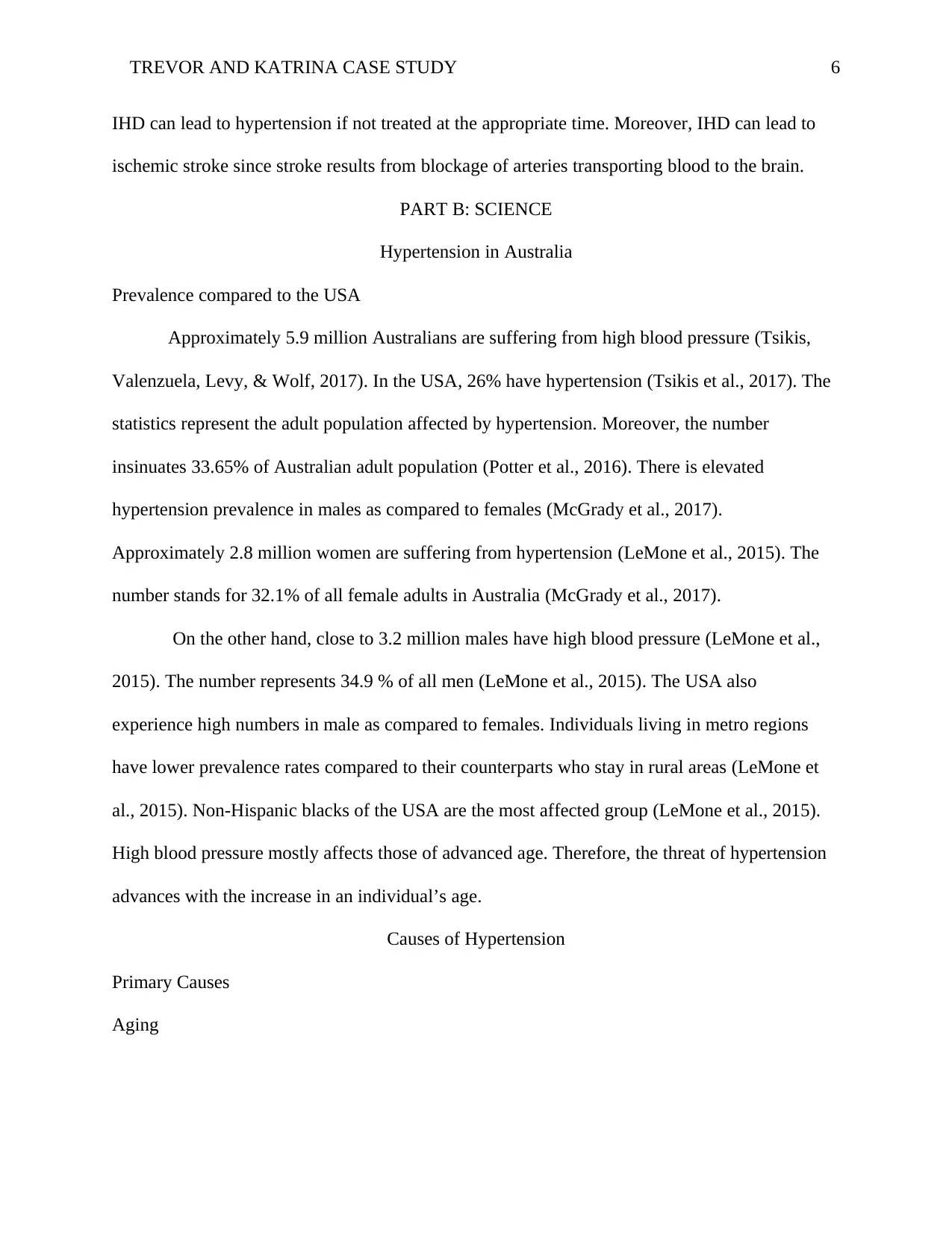
TREVOR AND KATRINA CASE STUDY 6
IHD can lead to hypertension if not treated at the appropriate time. Moreover, IHD can lead to
ischemic stroke since stroke results from blockage of arteries transporting blood to the brain.
PART B: SCIENCE
Hypertension in Australia
Prevalence compared to the USA
Approximately 5.9 million Australians are suffering from high blood pressure (Tsikis,
Valenzuela, Levy, & Wolf, 2017). In the USA, 26% have hypertension (Tsikis et al., 2017). The
statistics represent the adult population affected by hypertension. Moreover, the number
insinuates 33.65% of Australian adult population (Potter et al., 2016). There is elevated
hypertension prevalence in males as compared to females (McGrady et al., 2017).
Approximately 2.8 million women are suffering from hypertension (LeMone et al., 2015). The
number stands for 32.1% of all female adults in Australia (McGrady et al., 2017).
On the other hand, close to 3.2 million males have high blood pressure (LeMone et al.,
2015). The number represents 34.9 % of all men (LeMone et al., 2015). The USA also
experience high numbers in male as compared to females. Individuals living in metro regions
have lower prevalence rates compared to their counterparts who stay in rural areas (LeMone et
al., 2015). Non-Hispanic blacks of the USA are the most affected group (LeMone et al., 2015).
High blood pressure mostly affects those of advanced age. Therefore, the threat of hypertension
advances with the increase in an individual’s age.
Causes of Hypertension
Primary Causes
Aging
IHD can lead to hypertension if not treated at the appropriate time. Moreover, IHD can lead to
ischemic stroke since stroke results from blockage of arteries transporting blood to the brain.
PART B: SCIENCE
Hypertension in Australia
Prevalence compared to the USA
Approximately 5.9 million Australians are suffering from high blood pressure (Tsikis,
Valenzuela, Levy, & Wolf, 2017). In the USA, 26% have hypertension (Tsikis et al., 2017). The
statistics represent the adult population affected by hypertension. Moreover, the number
insinuates 33.65% of Australian adult population (Potter et al., 2016). There is elevated
hypertension prevalence in males as compared to females (McGrady et al., 2017).
Approximately 2.8 million women are suffering from hypertension (LeMone et al., 2015). The
number stands for 32.1% of all female adults in Australia (McGrady et al., 2017).
On the other hand, close to 3.2 million males have high blood pressure (LeMone et al.,
2015). The number represents 34.9 % of all men (LeMone et al., 2015). The USA also
experience high numbers in male as compared to females. Individuals living in metro regions
have lower prevalence rates compared to their counterparts who stay in rural areas (LeMone et
al., 2015). Non-Hispanic blacks of the USA are the most affected group (LeMone et al., 2015).
High blood pressure mostly affects those of advanced age. Therefore, the threat of hypertension
advances with the increase in an individual’s age.
Causes of Hypertension
Primary Causes
Aging
⊘ This is a preview!⊘
Do you want full access?
Subscribe today to unlock all pages.

Trusted by 1+ million students worldwide
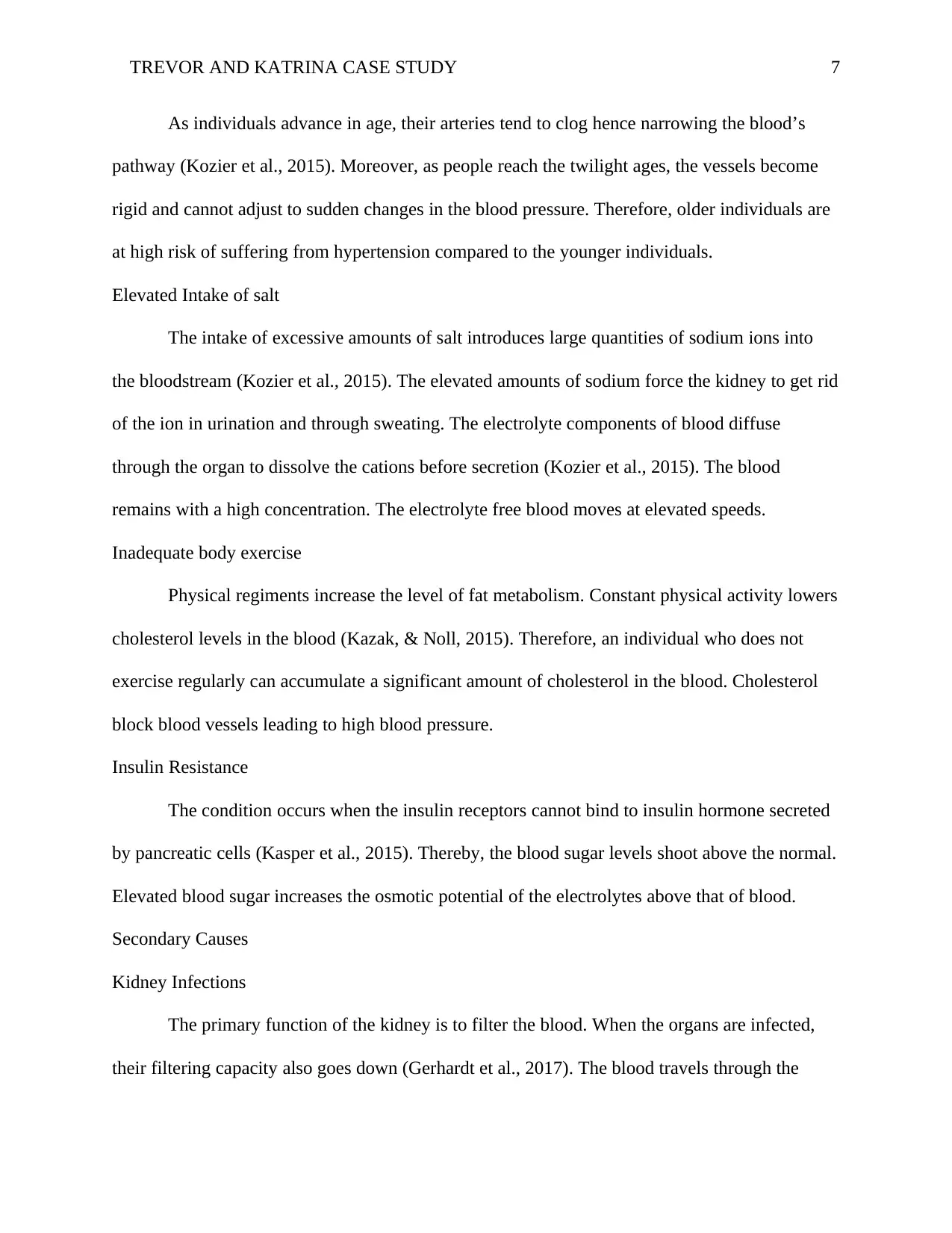
TREVOR AND KATRINA CASE STUDY 7
As individuals advance in age, their arteries tend to clog hence narrowing the blood’s
pathway (Kozier et al., 2015). Moreover, as people reach the twilight ages, the vessels become
rigid and cannot adjust to sudden changes in the blood pressure. Therefore, older individuals are
at high risk of suffering from hypertension compared to the younger individuals.
Elevated Intake of salt
The intake of excessive amounts of salt introduces large quantities of sodium ions into
the bloodstream (Kozier et al., 2015). The elevated amounts of sodium force the kidney to get rid
of the ion in urination and through sweating. The electrolyte components of blood diffuse
through the organ to dissolve the cations before secretion (Kozier et al., 2015). The blood
remains with a high concentration. The electrolyte free blood moves at elevated speeds.
Inadequate body exercise
Physical regiments increase the level of fat metabolism. Constant physical activity lowers
cholesterol levels in the blood (Kazak, & Noll, 2015). Therefore, an individual who does not
exercise regularly can accumulate a significant amount of cholesterol in the blood. Cholesterol
block blood vessels leading to high blood pressure.
Insulin Resistance
The condition occurs when the insulin receptors cannot bind to insulin hormone secreted
by pancreatic cells (Kasper et al., 2015). Thereby, the blood sugar levels shoot above the normal.
Elevated blood sugar increases the osmotic potential of the electrolytes above that of blood.
Secondary Causes
Kidney Infections
The primary function of the kidney is to filter the blood. When the organs are infected,
their filtering capacity also goes down (Gerhardt et al., 2017). The blood travels through the
As individuals advance in age, their arteries tend to clog hence narrowing the blood’s
pathway (Kozier et al., 2015). Moreover, as people reach the twilight ages, the vessels become
rigid and cannot adjust to sudden changes in the blood pressure. Therefore, older individuals are
at high risk of suffering from hypertension compared to the younger individuals.
Elevated Intake of salt
The intake of excessive amounts of salt introduces large quantities of sodium ions into
the bloodstream (Kozier et al., 2015). The elevated amounts of sodium force the kidney to get rid
of the ion in urination and through sweating. The electrolyte components of blood diffuse
through the organ to dissolve the cations before secretion (Kozier et al., 2015). The blood
remains with a high concentration. The electrolyte free blood moves at elevated speeds.
Inadequate body exercise
Physical regiments increase the level of fat metabolism. Constant physical activity lowers
cholesterol levels in the blood (Kazak, & Noll, 2015). Therefore, an individual who does not
exercise regularly can accumulate a significant amount of cholesterol in the blood. Cholesterol
block blood vessels leading to high blood pressure.
Insulin Resistance
The condition occurs when the insulin receptors cannot bind to insulin hormone secreted
by pancreatic cells (Kasper et al., 2015). Thereby, the blood sugar levels shoot above the normal.
Elevated blood sugar increases the osmotic potential of the electrolytes above that of blood.
Secondary Causes
Kidney Infections
The primary function of the kidney is to filter the blood. When the organs are infected,
their filtering capacity also goes down (Gerhardt et al., 2017). The blood travels through the
Paraphrase This Document
Need a fresh take? Get an instant paraphrase of this document with our AI Paraphraser
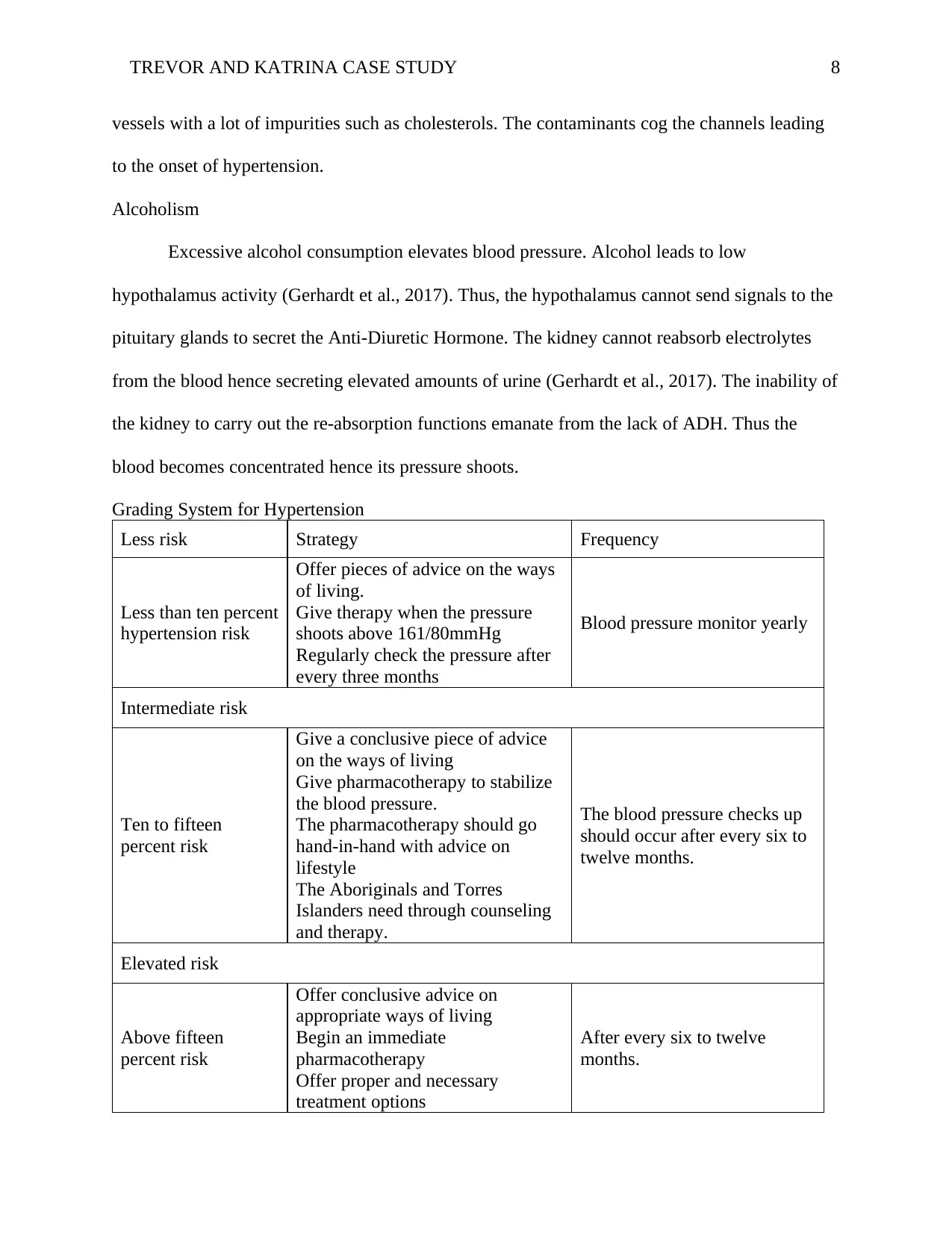
TREVOR AND KATRINA CASE STUDY 8
vessels with a lot of impurities such as cholesterols. The contaminants cog the channels leading
to the onset of hypertension.
Alcoholism
Excessive alcohol consumption elevates blood pressure. Alcohol leads to low
hypothalamus activity (Gerhardt et al., 2017). Thus, the hypothalamus cannot send signals to the
pituitary glands to secret the Anti-Diuretic Hormone. The kidney cannot reabsorb electrolytes
from the blood hence secreting elevated amounts of urine (Gerhardt et al., 2017). The inability of
the kidney to carry out the re-absorption functions emanate from the lack of ADH. Thus the
blood becomes concentrated hence its pressure shoots.
Grading System for Hypertension
Less risk Strategy Frequency
Less than ten percent
hypertension risk
Offer pieces of advice on the ways
of living.
Give therapy when the pressure
shoots above 161/80mmHg
Regularly check the pressure after
every three months
Blood pressure monitor yearly
Intermediate risk
Ten to fifteen
percent risk
Give a conclusive piece of advice
on the ways of living
Give pharmacotherapy to stabilize
the blood pressure.
The pharmacotherapy should go
hand-in-hand with advice on
lifestyle
The Aboriginals and Torres
Islanders need through counseling
and therapy.
The blood pressure checks up
should occur after every six to
twelve months.
Elevated risk
Above fifteen
percent risk
Offer conclusive advice on
appropriate ways of living
Begin an immediate
pharmacotherapy
Offer proper and necessary
treatment options
After every six to twelve
months.
vessels with a lot of impurities such as cholesterols. The contaminants cog the channels leading
to the onset of hypertension.
Alcoholism
Excessive alcohol consumption elevates blood pressure. Alcohol leads to low
hypothalamus activity (Gerhardt et al., 2017). Thus, the hypothalamus cannot send signals to the
pituitary glands to secret the Anti-Diuretic Hormone. The kidney cannot reabsorb electrolytes
from the blood hence secreting elevated amounts of urine (Gerhardt et al., 2017). The inability of
the kidney to carry out the re-absorption functions emanate from the lack of ADH. Thus the
blood becomes concentrated hence its pressure shoots.
Grading System for Hypertension
Less risk Strategy Frequency
Less than ten percent
hypertension risk
Offer pieces of advice on the ways
of living.
Give therapy when the pressure
shoots above 161/80mmHg
Regularly check the pressure after
every three months
Blood pressure monitor yearly
Intermediate risk
Ten to fifteen
percent risk
Give a conclusive piece of advice
on the ways of living
Give pharmacotherapy to stabilize
the blood pressure.
The pharmacotherapy should go
hand-in-hand with advice on
lifestyle
The Aboriginals and Torres
Islanders need through counseling
and therapy.
The blood pressure checks up
should occur after every six to
twelve months.
Elevated risk
Above fifteen
percent risk
Offer conclusive advice on
appropriate ways of living
Begin an immediate
pharmacotherapy
Offer proper and necessary
treatment options
After every six to twelve
months.
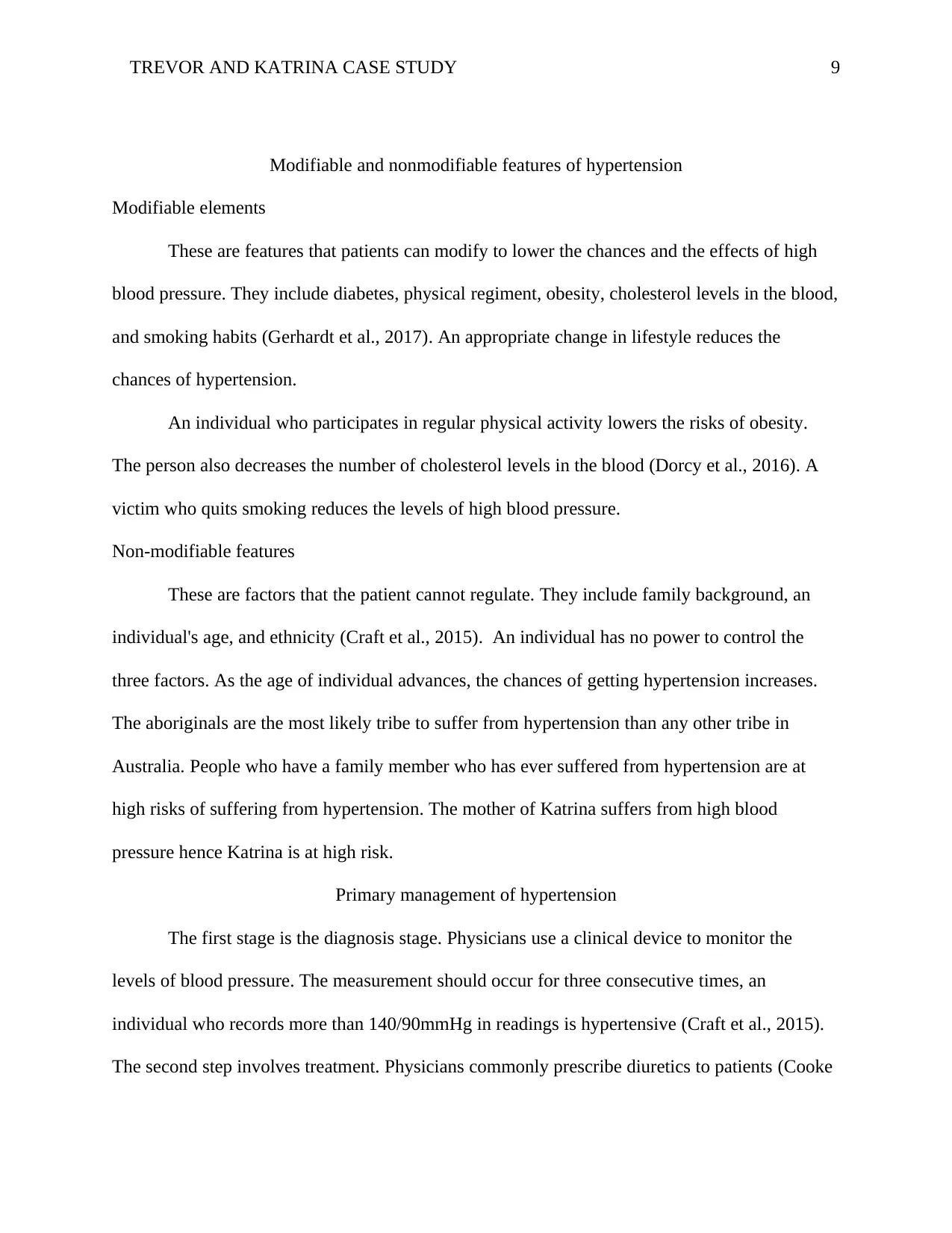
TREVOR AND KATRINA CASE STUDY 9
Modifiable and nonmodifiable features of hypertension
Modifiable elements
These are features that patients can modify to lower the chances and the effects of high
blood pressure. They include diabetes, physical regiment, obesity, cholesterol levels in the blood,
and smoking habits (Gerhardt et al., 2017). An appropriate change in lifestyle reduces the
chances of hypertension.
An individual who participates in regular physical activity lowers the risks of obesity.
The person also decreases the number of cholesterol levels in the blood (Dorcy et al., 2016). A
victim who quits smoking reduces the levels of high blood pressure.
Non-modifiable features
These are factors that the patient cannot regulate. They include family background, an
individual's age, and ethnicity (Craft et al., 2015). An individual has no power to control the
three factors. As the age of individual advances, the chances of getting hypertension increases.
The aboriginals are the most likely tribe to suffer from hypertension than any other tribe in
Australia. People who have a family member who has ever suffered from hypertension are at
high risks of suffering from hypertension. The mother of Katrina suffers from high blood
pressure hence Katrina is at high risk.
Primary management of hypertension
The first stage is the diagnosis stage. Physicians use a clinical device to monitor the
levels of blood pressure. The measurement should occur for three consecutive times, an
individual who records more than 140/90mmHg in readings is hypertensive (Craft et al., 2015).
The second step involves treatment. Physicians commonly prescribe diuretics to patients (Cooke
Modifiable and nonmodifiable features of hypertension
Modifiable elements
These are features that patients can modify to lower the chances and the effects of high
blood pressure. They include diabetes, physical regiment, obesity, cholesterol levels in the blood,
and smoking habits (Gerhardt et al., 2017). An appropriate change in lifestyle reduces the
chances of hypertension.
An individual who participates in regular physical activity lowers the risks of obesity.
The person also decreases the number of cholesterol levels in the blood (Dorcy et al., 2016). A
victim who quits smoking reduces the levels of high blood pressure.
Non-modifiable features
These are factors that the patient cannot regulate. They include family background, an
individual's age, and ethnicity (Craft et al., 2015). An individual has no power to control the
three factors. As the age of individual advances, the chances of getting hypertension increases.
The aboriginals are the most likely tribe to suffer from hypertension than any other tribe in
Australia. People who have a family member who has ever suffered from hypertension are at
high risks of suffering from hypertension. The mother of Katrina suffers from high blood
pressure hence Katrina is at high risk.
Primary management of hypertension
The first stage is the diagnosis stage. Physicians use a clinical device to monitor the
levels of blood pressure. The measurement should occur for three consecutive times, an
individual who records more than 140/90mmHg in readings is hypertensive (Craft et al., 2015).
The second step involves treatment. Physicians commonly prescribe diuretics to patients (Cooke
⊘ This is a preview!⊘
Do you want full access?
Subscribe today to unlock all pages.

Trusted by 1+ million students worldwide
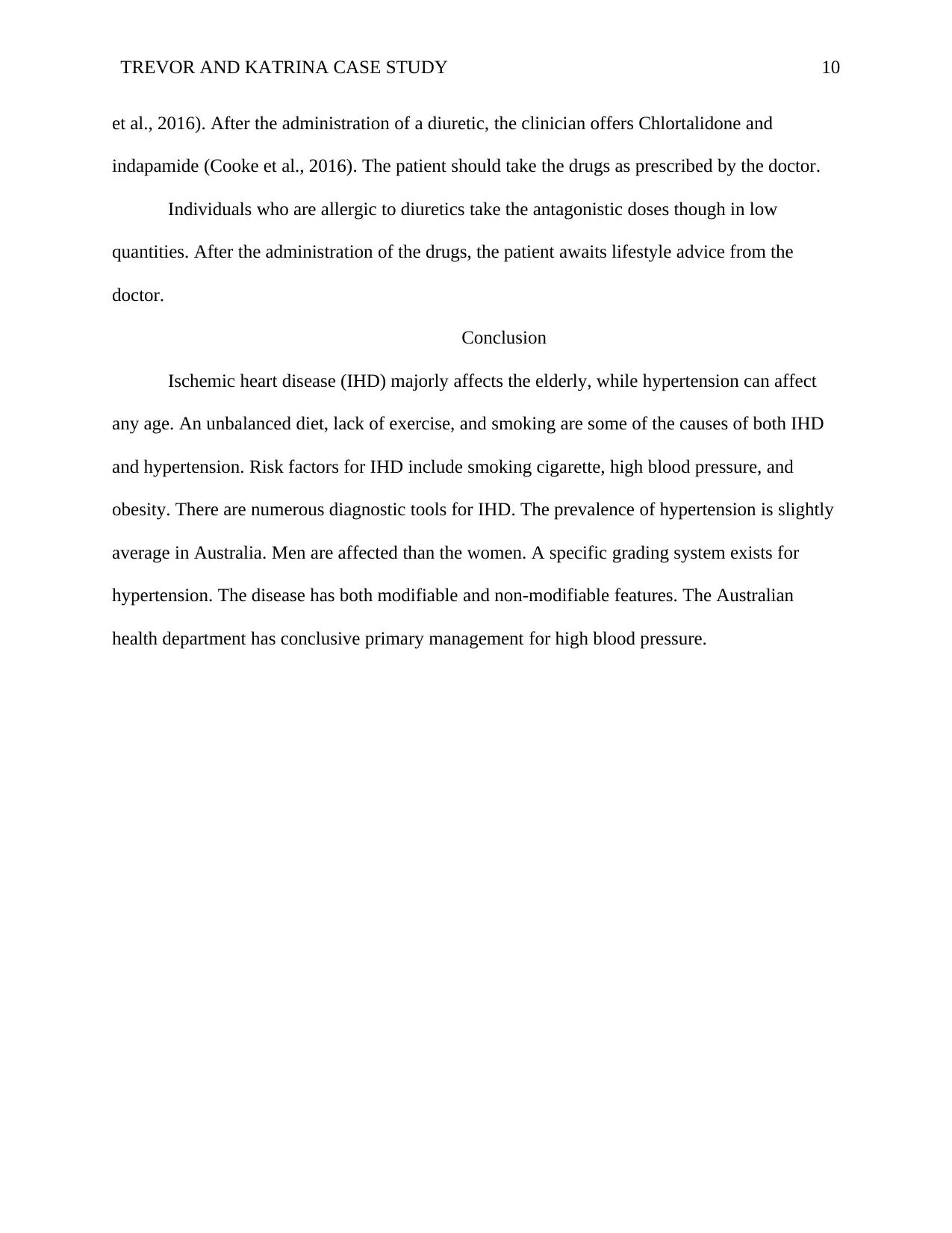
TREVOR AND KATRINA CASE STUDY 10
et al., 2016). After the administration of a diuretic, the clinician offers Chlortalidone and
indapamide (Cooke et al., 2016). The patient should take the drugs as prescribed by the doctor.
Individuals who are allergic to diuretics take the antagonistic doses though in low
quantities. After the administration of the drugs, the patient awaits lifestyle advice from the
doctor.
Conclusion
Ischemic heart disease (IHD) majorly affects the elderly, while hypertension can affect
any age. An unbalanced diet, lack of exercise, and smoking are some of the causes of both IHD
and hypertension. Risk factors for IHD include smoking cigarette, high blood pressure, and
obesity. There are numerous diagnostic tools for IHD. The prevalence of hypertension is slightly
average in Australia. Men are affected than the women. A specific grading system exists for
hypertension. The disease has both modifiable and non-modifiable features. The Australian
health department has conclusive primary management for high blood pressure.
et al., 2016). After the administration of a diuretic, the clinician offers Chlortalidone and
indapamide (Cooke et al., 2016). The patient should take the drugs as prescribed by the doctor.
Individuals who are allergic to diuretics take the antagonistic doses though in low
quantities. After the administration of the drugs, the patient awaits lifestyle advice from the
doctor.
Conclusion
Ischemic heart disease (IHD) majorly affects the elderly, while hypertension can affect
any age. An unbalanced diet, lack of exercise, and smoking are some of the causes of both IHD
and hypertension. Risk factors for IHD include smoking cigarette, high blood pressure, and
obesity. There are numerous diagnostic tools for IHD. The prevalence of hypertension is slightly
average in Australia. Men are affected than the women. A specific grading system exists for
hypertension. The disease has both modifiable and non-modifiable features. The Australian
health department has conclusive primary management for high blood pressure.
Paraphrase This Document
Need a fresh take? Get an instant paraphrase of this document with our AI Paraphraser
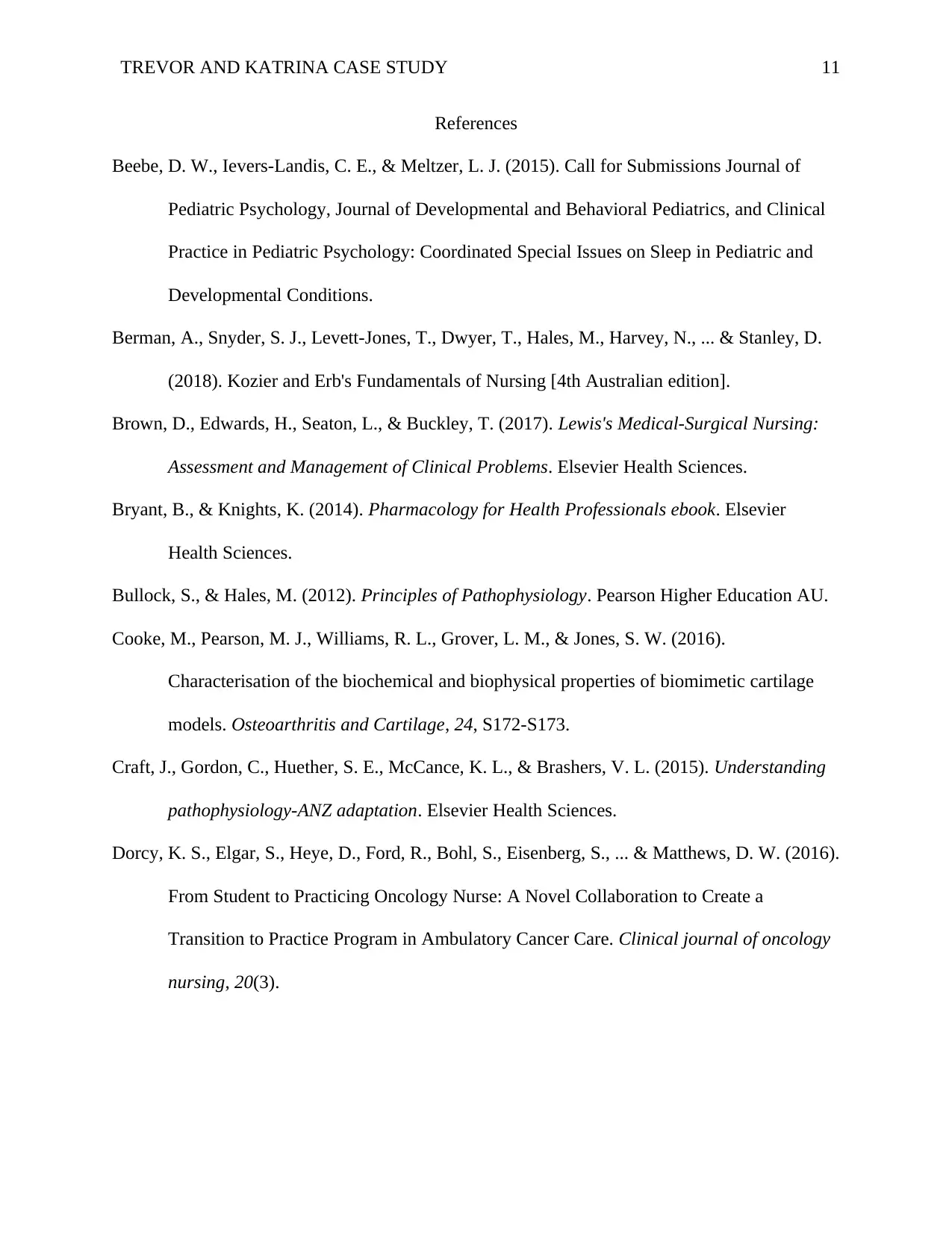
TREVOR AND KATRINA CASE STUDY 11
References
Beebe, D. W., Ievers-Landis, C. E., & Meltzer, L. J. (2015). Call for Submissions Journal of
Pediatric Psychology, Journal of Developmental and Behavioral Pediatrics, and Clinical
Practice in Pediatric Psychology: Coordinated Special Issues on Sleep in Pediatric and
Developmental Conditions.
Berman, A., Snyder, S. J., Levett-Jones, T., Dwyer, T., Hales, M., Harvey, N., ... & Stanley, D.
(2018). Kozier and Erb's Fundamentals of Nursing [4th Australian edition].
Brown, D., Edwards, H., Seaton, L., & Buckley, T. (2017). Lewis's Medical-Surgical Nursing:
Assessment and Management of Clinical Problems. Elsevier Health Sciences.
Bryant, B., & Knights, K. (2014). Pharmacology for Health Professionals ebook. Elsevier
Health Sciences.
Bullock, S., & Hales, M. (2012). Principles of Pathophysiology. Pearson Higher Education AU.
Cooke, M., Pearson, M. J., Williams, R. L., Grover, L. M., & Jones, S. W. (2016).
Characterisation of the biochemical and biophysical properties of biomimetic cartilage
models. Osteoarthritis and Cartilage, 24, S172-S173.
Craft, J., Gordon, C., Huether, S. E., McCance, K. L., & Brashers, V. L. (2015). Understanding
pathophysiology-ANZ adaptation. Elsevier Health Sciences.
Dorcy, K. S., Elgar, S., Heye, D., Ford, R., Bohl, S., Eisenberg, S., ... & Matthews, D. W. (2016).
From Student to Practicing Oncology Nurse: A Novel Collaboration to Create a
Transition to Practice Program in Ambulatory Cancer Care. Clinical journal of oncology
nursing, 20(3).
References
Beebe, D. W., Ievers-Landis, C. E., & Meltzer, L. J. (2015). Call for Submissions Journal of
Pediatric Psychology, Journal of Developmental and Behavioral Pediatrics, and Clinical
Practice in Pediatric Psychology: Coordinated Special Issues on Sleep in Pediatric and
Developmental Conditions.
Berman, A., Snyder, S. J., Levett-Jones, T., Dwyer, T., Hales, M., Harvey, N., ... & Stanley, D.
(2018). Kozier and Erb's Fundamentals of Nursing [4th Australian edition].
Brown, D., Edwards, H., Seaton, L., & Buckley, T. (2017). Lewis's Medical-Surgical Nursing:
Assessment and Management of Clinical Problems. Elsevier Health Sciences.
Bryant, B., & Knights, K. (2014). Pharmacology for Health Professionals ebook. Elsevier
Health Sciences.
Bullock, S., & Hales, M. (2012). Principles of Pathophysiology. Pearson Higher Education AU.
Cooke, M., Pearson, M. J., Williams, R. L., Grover, L. M., & Jones, S. W. (2016).
Characterisation of the biochemical and biophysical properties of biomimetic cartilage
models. Osteoarthritis and Cartilage, 24, S172-S173.
Craft, J., Gordon, C., Huether, S. E., McCance, K. L., & Brashers, V. L. (2015). Understanding
pathophysiology-ANZ adaptation. Elsevier Health Sciences.
Dorcy, K. S., Elgar, S., Heye, D., Ford, R., Bohl, S., Eisenberg, S., ... & Matthews, D. W. (2016).
From Student to Practicing Oncology Nurse: A Novel Collaboration to Create a
Transition to Practice Program in Ambulatory Cancer Care. Clinical journal of oncology
nursing, 20(3).
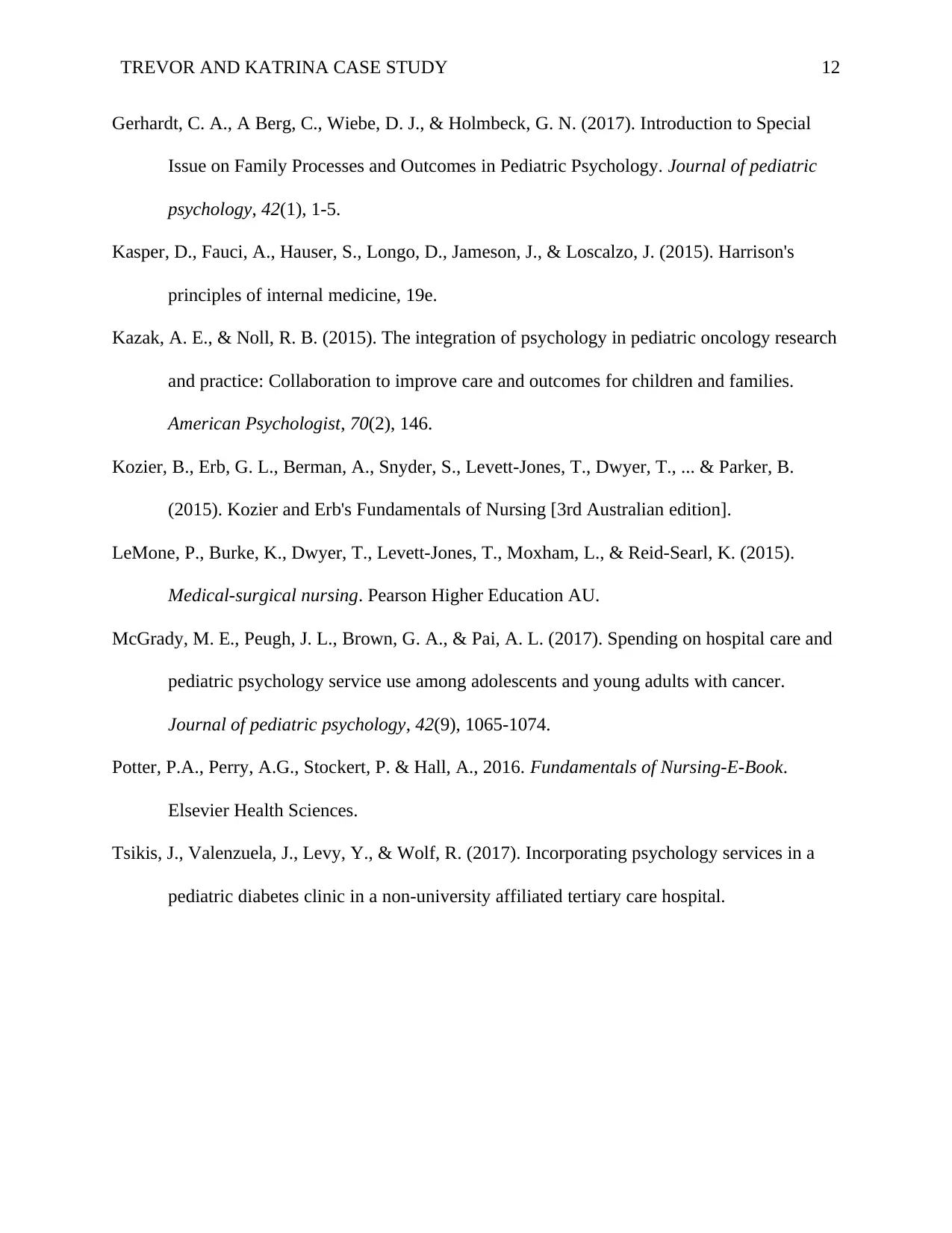
TREVOR AND KATRINA CASE STUDY 12
Gerhardt, C. A., A Berg, C., Wiebe, D. J., & Holmbeck, G. N. (2017). Introduction to Special
Issue on Family Processes and Outcomes in Pediatric Psychology. Journal of pediatric
psychology, 42(1), 1-5.
Kasper, D., Fauci, A., Hauser, S., Longo, D., Jameson, J., & Loscalzo, J. (2015). Harrison's
principles of internal medicine, 19e.
Kazak, A. E., & Noll, R. B. (2015). The integration of psychology in pediatric oncology research
and practice: Collaboration to improve care and outcomes for children and families.
American Psychologist, 70(2), 146.
Kozier, B., Erb, G. L., Berman, A., Snyder, S., Levett-Jones, T., Dwyer, T., ... & Parker, B.
(2015). Kozier and Erb's Fundamentals of Nursing [3rd Australian edition].
LeMone, P., Burke, K., Dwyer, T., Levett-Jones, T., Moxham, L., & Reid-Searl, K. (2015).
Medical-surgical nursing. Pearson Higher Education AU.
McGrady, M. E., Peugh, J. L., Brown, G. A., & Pai, A. L. (2017). Spending on hospital care and
pediatric psychology service use among adolescents and young adults with cancer.
Journal of pediatric psychology, 42(9), 1065-1074.
Potter, P.A., Perry, A.G., Stockert, P. & Hall, A., 2016. Fundamentals of Nursing-E-Book.
Elsevier Health Sciences.
Tsikis, J., Valenzuela, J., Levy, Y., & Wolf, R. (2017). Incorporating psychology services in a
pediatric diabetes clinic in a non-university affiliated tertiary care hospital.
Gerhardt, C. A., A Berg, C., Wiebe, D. J., & Holmbeck, G. N. (2017). Introduction to Special
Issue on Family Processes and Outcomes in Pediatric Psychology. Journal of pediatric
psychology, 42(1), 1-5.
Kasper, D., Fauci, A., Hauser, S., Longo, D., Jameson, J., & Loscalzo, J. (2015). Harrison's
principles of internal medicine, 19e.
Kazak, A. E., & Noll, R. B. (2015). The integration of psychology in pediatric oncology research
and practice: Collaboration to improve care and outcomes for children and families.
American Psychologist, 70(2), 146.
Kozier, B., Erb, G. L., Berman, A., Snyder, S., Levett-Jones, T., Dwyer, T., ... & Parker, B.
(2015). Kozier and Erb's Fundamentals of Nursing [3rd Australian edition].
LeMone, P., Burke, K., Dwyer, T., Levett-Jones, T., Moxham, L., & Reid-Searl, K. (2015).
Medical-surgical nursing. Pearson Higher Education AU.
McGrady, M. E., Peugh, J. L., Brown, G. A., & Pai, A. L. (2017). Spending on hospital care and
pediatric psychology service use among adolescents and young adults with cancer.
Journal of pediatric psychology, 42(9), 1065-1074.
Potter, P.A., Perry, A.G., Stockert, P. & Hall, A., 2016. Fundamentals of Nursing-E-Book.
Elsevier Health Sciences.
Tsikis, J., Valenzuela, J., Levy, Y., & Wolf, R. (2017). Incorporating psychology services in a
pediatric diabetes clinic in a non-university affiliated tertiary care hospital.
⊘ This is a preview!⊘
Do you want full access?
Subscribe today to unlock all pages.

Trusted by 1+ million students worldwide
1 out of 13
Related Documents
Your All-in-One AI-Powered Toolkit for Academic Success.
+13062052269
info@desklib.com
Available 24*7 on WhatsApp / Email
![[object Object]](/_next/static/media/star-bottom.7253800d.svg)
Unlock your academic potential
Copyright © 2020–2025 A2Z Services. All Rights Reserved. Developed and managed by ZUCOL.





